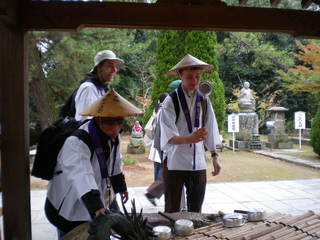14Nov10: Richard Kinsella
 A Heritage of Storytelling
A Heritage of Storytelling
Richard Kinsella
One of the most interesting aspects of walking the Shikoku Eighty-Eight Temple Circuit is discovering the local stories associated with each temple. If you have the opportunity to talk with a Buddhist priest, you can sense their eagerness and willingness to share their temple's legends. On our most recent section of the pilgrimage,on the Goshikidai Plateau, we were told tales of demon cows and angry spirits.
Japan's relationship with storytelling is long and well documented. I can't help but make parallels between Japanese stories of the past and the incarnation Japanese stories take today. After living on a small Japanese island for over a year, I have built friendships and relationships with many of the island people. Like the Buddhist priests they revel in sharing their local tales, which are always in abundance. One story comes to mind of a demon that lived by the edge of a river. After watching a man eat a bowl of somen noodles, the demon attacks the man and proceeds to rip open his stomach, so as attain the consumed noodles. The demon then washes the noodles in the river before eating them. To this day the river is still referred to as Somen River.
This heritage of storytelling has helped to shape much of Japan's culture, both in the past and the present. The Japanese people's desire to tell and record their stories lead to large scale distribution of printed material during the Edo Period. It defined the aesthetic of the era as wood block prints became a popular medium. Scrolls depicting the stories of the time would also play apart in the aesthetic of modern day Manga. The Manga industry now makes millions of dollars, demands miles of self space in book stores and continues to be a popular form of entertainment. Japan's love of storytelling is alive and well in contemporary culture but what makes Japanese storytelling so unique and why does it continue to play an important roles in modern day Japanese society?
Since coming to Japan, I have sought out many traditional Japanese tales. After growing up with stories such as Goldilocks and the Three Bears, Hansel and Gretel, and Little Red Riding Hood, I find it fascinating to find the same themes and ideals expressed in Japanese stories. Both Western and Japanese stories attempt to communicate a valuable life lesson to children. However, I find Japanese stories to be lighter in tone. They are often amusing or jovial and have very engaging characters. The monsters and villains depicted in Japanese stories are not two dimensional beasts. Many of them are lost spirits or demons willing to compromise. The depiction of these characters are often very entertaining. It is clear to see that the Japanese people are drawn to these wayward souls. Perhaps they empathize with their misgivings or perhaps the terror of encountering one of them is exhilarating. Either way, they play a key role in the success of Japanese storytelling and can still be seen in Japan's modern day stories.
Discovering and finding the stories behind these monsters have helped define my time in Japan. By speaking with the local people I have glimpsed the ideals of Japanese life and found the people to be warm and jovial in their manner of storytelling. In no place are the stories so vividly told as in the temples along the Shikoku Eighty-Eight Temple circuit. These local legends live on through practicing priests and pilgrims that pass through. The pilgrimage is a valuable resource that ensures that local stories endure. As long as people continue to visit these bastions of local heritage, the stories that have helped shape modern Japan will continue.